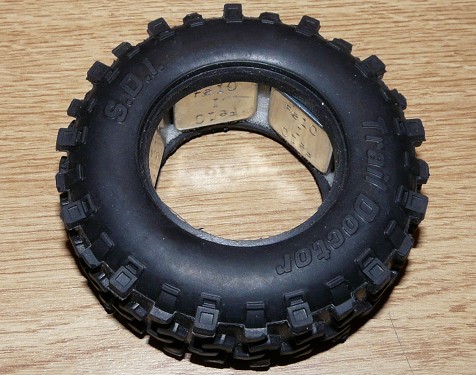Wheels and tires
For trailing, the grip is essential, just like with any other model: true, but here, it is even more important. The stock tires are multi-purpose, which is fine since you can run on any kind of surface. But all-purpose means no specialization when my model is only made for trailing. Thus the SDI tires which are a renown reference for this, with the great advantage of being compatible with the stock rims.
Comparison with stock tires

Modifying the foam inserts

The stock tires diameter is 78mm when the SDI Trail Doctor are 94mm: the difference is quite important, but their dimensions are the same as Tamiya's option tires reference 54483 or 54484. As for the tires, they are considerably softer than the stock ones, and the patterns are more prominent.
As for the foams, they are trimmed as depicted on the second photo. The idea is to reduce the foam efficiency in order for the tire to flatten more easily. Visually, the tire looks a little bit under-inflated, which is exactly what we want: whenever the tire hits an obstacle, it will slightly flatten, increasing the contact surface that will increase the grip of the tire. The drawback of this technique is instability since the tire wall is less rigid: for trailing, the grip being the most important factor, we need this surgery on the foams.
Another important aspect in trailing is the center of gravity. Being an off-road activity, the ground clearance needs to be high. Moreover, heavy parts like the chassis, the motor, the battery pack and the bodyshell (especially ABS ones) contribute to raise the center of gravity. To reduce the problem (thus the risk of roll-over), you ballast the wheels. There are several techniques available, among which the one I used:
Foam ballast

Foam ballast into the tire

I used lead wheel balancers sticked on the foam inner diameter. These wheel balancers can easily be found in any car center: politely ask for leftovers and you will get more than you need (generally pieces of 5 or 10g). Nice attention: they come with a self-adhesive band. My first idea was to stick them into the outer rim groove but they wouldn't fit without cutting the rims. So in total, each foam received 60g of ballast: I was aiming at 50g which is a good value, but the size of my balancers allowed me to fully fill the foam which is perfect for the ballast balance. Just fit the tire back onto the rim taking care of the ballast, cement-glue the tires and you're done.
Final result that depicts the under-inflated aspect when the tire works:
Idle

Just laying on the obstacle

Forcing the obstacle

Apart from the realistic tire aspect, it is mostly a question of grip: the more resistance against the obstacle, the more the tire "spreads" by increasing its surface. Please note the model needs to be fully equipped (bodyshell, battery pack etc) to get the desired effect (which may vary according to the volume of foam removed).




